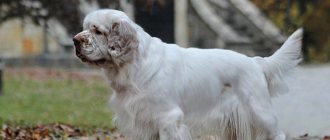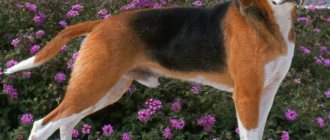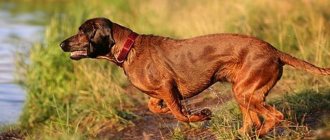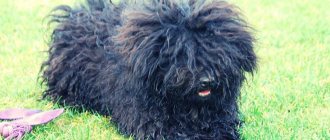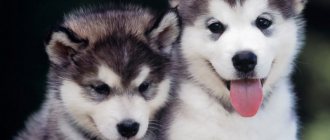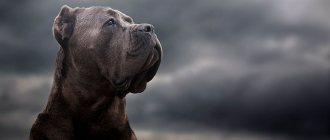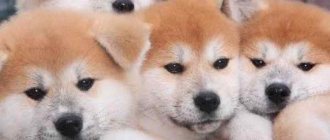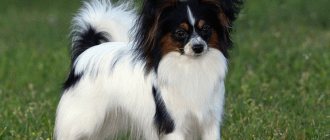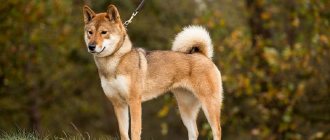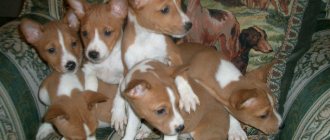Origin story
The history of the Utonagan breed began in the 80s of the 20th century, when several breeders from Great Britain set themselves the goal of breeding dogs that looked like a wolf. The result of painstaking work was a new breed - the Northern Inuit dog. Subsequently, disagreements arose between the breeders regarding the path of development of the breed and they were divided into small groups. Thus, the northern Inuit dogs gave rise to offshoot breed groups, including the Utonagan, Tamaskan, and British Timber Dog.
Utonagan is the result of crossing three breeds: Alaskan Malamute, German Shepherd, Siberian Husky.
To consolidate the desired qualities and expand the gene pool, Utonagan breeders began an outcrossing program in 2009 (reintroducing the blood of the founding breeds). The results were excellent both in terms of health and temperament.
Price when buying a Utonagan puppy
Unfortunately, the breed is only gaining momentum in its development. Therefore, as such, Utonagan kennels have not yet been registered in Russia; there are only the first modest experimental attempts by breeders to breed these dogs from representatives of the breed imported directly from Great Britain. The lack of official recognition of these dogs also contributes. It is difficult and economically unprofitable for dog breeders to breed animals with an uncertain status and a complete lack of breed standards. Nobody wants to grow someone unknown.
For this reason, purchasing a dog-wolf in Russia is problematic; you can easily run into scammers who will sell you a husky or malamute mix, or even a completely mongrel “nobleman” under the guise of a scarce and expensive utonagan for a lot of money.
Based on the above, we can conclude that it is best to buy a dog-wolf puppy now directly in its home territory - in the UK. There, the price of a Utonagan puppy, depending on its size, gender and color, will cost from 600 pounds sterling (approximately 780 US dollars) and more. But on the other hand, you will be completely sure of the origin of your pet and will be able to receive the necessary professional advice on its maintenance.
For more educational information about utonagan, watch this video:
Appearance
The Utonagan is a large, strong, lightly built dog. Well balanced, which is reflected in agility, speed and power. At first glance it resembles a wolf. Sexual dimorphism is well expressed. Males are noticeably stronger and larger.
- Height at withers: 61-84 cm.
- Weight: 25-50 kg.
The head is proportional, never too wide. The eyes are almond-shaped, from light amber to dark brown. The muzzle is quite long. The lobe is dark brown or black. The ears are set wide apart, the tips slightly rounded. The jaws are powerful and well developed. Scissor bite. The neck is long, strong, and seems heavy due to the abundant “mane.”
Although the utonagan often looks like a wolf, it does not contain the blood of its wild relatives.
The chest is narrow, the shoulders are moderately sloping. The forelimbs are straight, long, spaced at a short distance from each other, elbows pressed to the body. The case has a slightly stretched format. The topline is level. The hind limbs are powerful, muscular, wider apart than the forelimbs, parallel. The feet are webbed, the front feet are oval and large, the back feet are smaller. The tail is long, often with a thick dewlap.
The coat is dense, thick, straight. The coat in the summer months is very different from the winter, when an abundant undercoat grows. The traditional color of the utonagan is zonal.
Character and behavior
The British Wolfdog is intelligent and strong-willed, but not aggressive. Gets along well with children. She has a balanced temperament and a high degree of adaptability. With proper socialization, he will be an excellent family pet. But this is not the best choice for an inexperienced dog owner.
The Utonagan was bred to look like a wolf, but not for any specific job.
These dogs are very intelligent and people-oriented. They are quite trainable in experienced hands and learn quickly, but their size and tendency to get bored with nothing to do can be a problem. Utonagans require clear boundaries and a firm hand, but not cruelty.
Utonagan loves company and suffers greatly from separation. He should receive daily physical and mental stimulation. Not suitable for guard duty and absolutely not suitable for bodyguard work.
Description of utonagan
The breed is in its formation stage, and while its main principle - resemblance to a wolf - is interpreted differently by breeders. A breed standard is also under development, some positions of which have not yet been finalized.
Appearance
The spirit of the wolf has found its absolute embodiment in the appearance of the new breed: the utonagan is indeed very similar to a wild predator, but still it is some kind of cartoonish, lightweight version of the wolf. It is noticeably inferior to its standard in terms of build power, bone volume and head volume.
Accordingly, the dimensions of a wolf dog are not so impressive. With a respectable height (up to 73 cm at the withers in males and up to 66 cm in females), the weight of the utonagan is relatively small - for different breed types it can range from 25 to 50 kg.
We recommend reading: Frederic Pignon, Magali Delgado: “The meaning of life is to be happy!”
Yes, he looks like a wolf, but like some kind of not very real one - a fairy tale one
Acceptable breed colors:
- pure white;
- creamy;
- silver gray;
- wolfish;
- brown;
- black.
New color variants are appearing in the breed, and the experimental standard currently regulates them loosely. Regardless of the main color of the coat, there should be a characteristic wolf “mask” on the face, and there may be white spots on the chest, but not too large. The darkest coat is on the back, and on the belly, neck and feathers the fur can be noticeably lighter.
Fans of the breed believe that it will develop towards expanding the palette of colors, although this will somewhat weaken the authenticity of the wolf image.
Photo gallery: some colors of Utonogan
Wolf color is the most natural and common in the breed Light shades of wolf color look more elegant than dark ones Black utonagan looks mystical Warm creamy, golden and red shades of fur suit the “good wolf” very much
An important role in the exterior should be played by the characteristic shape of the head (now it is smaller and more graceful than that of a wolf), the location and color of the eyes (preference is given to amber shades of the iris, although the standard has not yet finally decided on this issue). The fur of the Utonagans also attracts attention - it is not wolf-like at first glance: the fur of the representatives of the young breed is longer, thicker and looks much more impressive. In winter, the undercoat becomes much more abundant than in summer.
Utonagana is “distinguished” by its luxurious tail - in length and set it is similar to a wolf’s, but it is much more richly covered. The dog seems to be aware of this - he carries his beautiful tail proudly, like a peacock.
Utonagan's movements are graceful and perfect
Character and behavior
Utonagans are temperamental and playful; adult dogs retain their cheerful puppy disposition. If they do not receive enough attention from the owner, they begin to get bored and become mischievous from idleness. Some dogs of this breed can howl and “sing” out of nothing to do, which shocks impressionable neighbors.
They are cramped and not very comfortable in a city apartment, even with regular long walks - they constantly need fresh emotions and food for thought. In search of new experiences, they often make tunnels and run away from the plots into open space.
They adore the owner and his family, are very affectionate and try with all their might to earn praise. They are friends with children and willingly play, but they should not be left alone with children - after playing, the dog does not feel its size, does not calculate its strength and can push the child. They get along well with domestic animals, especially dogs of any breed.
Health
Strong immunity and good health are the undoubted advantages of utonagans. Dogs rarely get sick, their average life expectancy is 14–15 years, and on English-language forums you can also find information about pets who have celebrated their twentieth anniversary - this is an enviable age for large dogs.
Unfortunately, typical diseases received mainly from northern ancestors also make themselves felt; we need to highlight the following:
- hip dysplasia;
- epilepsy;
- Addison's disease (chronic adrenal insufficiency);
- von Willebrand-Diana disease (a hereditary blood disease characterized by the occurrence of episodic spontaneous bleeding);
- various eye problems.
Advantages and disadvantages
Every breed has its own advantages and disadvantages, and the Utonagan is no exception. Evaluate them in relation to your lifestyle and preferences to see if this special wolf dog is right for you.
Table: pros and cons of utonagan
| Advantages of the breed | Disadvantages of the breed |
|
|
We recommend reading: Caucasian Shepherd Dog: a serious giant
If you are ready, welcome this dog into your home and your heart.
Content Features
The Utonagan is a very energetic and resilient dog. Perfect for people who lead an active lifestyle. Like the parent breeds, it requires regular walks or free time to run around in a well-fenced yard. Lack of exercise leads to the development of behavioral problems. Suitable for indoor and outdoor use.
Although the utonagan looks like a wolf, it definitely does not intend to hunt for prey. Like other dogs, he needs a balanced diet in the form of natural food or ready-made industrial food.
Moderate shedding occurs almost all year round, and is abundant in autumn and spring. Caring for your dog includes standard hygiene procedures as needed.
Canagan
Canagan is a super-premium food (holistic, grain-free), which is produced only in the UK.
The manufacturing company emphasizes that all food corresponds to the natural biological diet of dogs.
A distinctive feature of Canagan is the absence of grains, by-products and “chemicals” in its composition, the presence of a lot of natural dietary meat, and vegetables, fruits, berries and medicinal herbs are used as vitamins. There is no corn, wheat or other cheap food fillers. The preservative is a mixture of tocopherols (vitamins A and E). These foods are truly complete and provide the dog with all the substances its body needs.
Why choose Canagan?
Canagan dry food does not contain dyes, preservatives or flavor enhancers , which is a common sin among economy-class food manufacturers. A completely natural composition is the key to the health and longevity of your pet.
How does Canagan differ from other premium segment foods?
The dry food contains a lot of meat, including venison, rabbit and duck fillets, which are easily digestible dietary sources of protein, as well as boneless salmon and trout fillets, rich in omega fatty acids necessary for normal functioning of the body, shiny coat and excellent health. The chicken contained in Canagan feeds is an excellent source of protein. And vitamins, phosphorus and selenium help the harmonious functioning of the immune system.
Should I feed my dog other food?
Thanks to the balanced composition, you will not need to feed your pet with additional food, because... Canagan contains all the microelements and vitamins necessary for the body. And the exquisite taste of meat with herbs will make the transition to food easy and pleasant.
Can Canagan cause allergies in dogs?
Nutritional sensitivities are very common in pets. The most common are skin problems (itching and hair loss), vomiting or diarrhea. All Canagan minimize the risk of food sensitivities and are specifically formulated to help your pet live a long, happy life. In dry food, the main allergens are dyes, preservatives (for long shelf life), flavor enhancers (flavoring additives), grains (contain gluten and gluten). Super premium food uses only natural ingredients . Therefore, Canagan practically hypoallergenic, as evidenced by customer reviews.
Are there medicinal foods in the line?
It must be remembered that medicated food can only be purchased after consultation with a veterinarian. Currently, the brand does not offer any specialized medicinal food, but any doctor will advise you to feed your sick pet healthy and wholesome food. Canagan food is completely natural, contains a lot of dietary meat, medicinal herbs, fortified fruits and vegetables, salmon and trout meat and oil, so it is not only safe, but also beneficial for a sick animal. All Canagan are grain-free, and there is a line of foods for older and overweight dogs. Be healthy!
Is the food suitable for sterilized and overweight dogs?
Canagan range of foods is designed to meet the different needs of animals and different age and weight categories, so there is something for everyone. The lean meat in the composition makes it nutritious and dietary at the same time. For “fat people” the usual recommended doses should be reduced by 10%, for “skinny people” - increased accordingly.
How does Canagan affect wool?
Salmon food is rich in omega fatty acids, which quickly transform even the dullest coat, and according to customer reviews, after just a week of using the food, the animal’s coat becomes shiny and glossy.
m. Akademicheskaya st. Dmitry Ulyanov, building 24Phone: 8 (499) 124-29-17
m. Varshavskaya Chongarsky Boulevard, building 10 Telephone: 8 (985) 649-08-20
